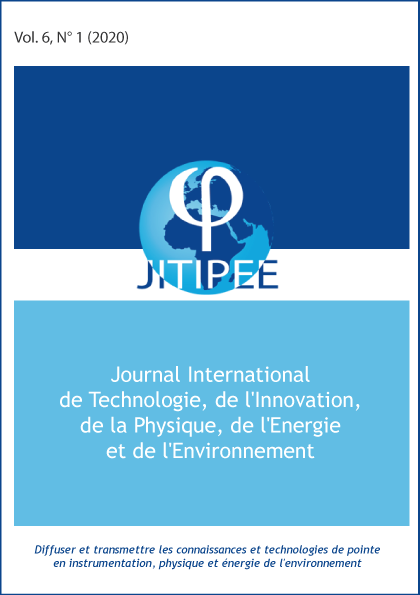Étude du comportement d’une fissure dans un multicouche soumis à la flexion quatre points : cas d’une fissure elliptique enterrée
DOI :
https://doi.org/10.18145/jitipee.v6i1.252Résumé
Le multicouche est au cœur de l’évolution de l’industrie moderne, nous le rencontrons dans plusieurs édifices. Ce travail a permis, après validation numérique du problème de traction uniforme résolu analytiquement par Sneddon, de montrer l’efficacité de notre méthode d’étude pour traiter les problèmes de fissure partiellement ouverte. En plus de cela, nous avons pu mettre en évidence l’efficacité de la méthode pour traiter les problèmes de fissuration dans les multicouches. L’étude de la flexion quatre points appliqués à un domaine homogène et un multicouche ayant les mêmes propriétés mécaniques montrent un bon accord entre les résultats du domaine homogène et du domaine multicouche. Ces résultats consolident notre approche et pour terminer nous avons initié l’étude d’un milieu hétérogène. À travers cette dernière partie nous avons pu mettre en évidence l’influence des interfaces sur l’évolution des facteurs d’intensité de contrainte. Cependant notre étude doit être approfondie avec d’autres exemples car en ingénierie l’utilisation des structures multicouche est très répandue.
Références
F.C.Franck, R.B. Lawn,(1967), «On the theory of Hertzian fracture», Proc Roy Soc a; p.299-291.Doi: https://doi.org/10.1098/rspa.1967.0137
R.Mouginot, D.Maugis,(1985), «Fracture indentation beneath flatand spherical punches.», J.MaterSci; Vol 20, p.4354–4376.Doi: https://doi.org/10.1007/BF00559324
R. Mouginot,(1987),«Crack formation beneath sliding spherical punches.»,J.Mater Sci; Vol 22, p. 989–1000.Doi: https://doi.org/10.1007/BF01103541
M.B. Bush,(1999), «Simulation of contact-induced fracture.»,Eng. Anal.Bound Elem; Vol. 23, p. 59-66.Doi: https://doi.org/10.1016/S0955-7997(98)00061-7
JITIPEE vol.6:n°1: 1 (2020)1-19
K. Komvopoulos,(1996),«Subsurface crack mechanisms under indentation loading. Wear.»,WEAR, Vol 199, p 9-23.Doi: https://doi.org/10.1016/0043-1648(96)06954-2
H.J. Choi, (2001), «Effects of graded layering on the tip behavior of vertical crack in a substrate under frictional Hertzian contact.»,Engng Fract Mech; Vol 68, p. 1033-1059.Doi: https://doi.org/10.1016/S0013-7944(01)00003-0
T.A.Cruse, W. Vanburen,(1971), «Three-dimensional stress analysis of a fracture specimen with an edge cracks.»,Int J Fract; Vol 71(1), p. 1-15.Doi:https://doi.org/10.1007/BF00236479
Y. Mi, M.H. Aliabadi,(1992), «Dual boundary element method for three-dimensional fracturemechanics analysis.»,Engng Anal Bound Elem; Vol 10, p. 161-171.Doi: https://doi.org/10.1016/0955-7997(92)90047-B
J.Dominguez, M.P.Ariza, R.Gallego,(2000), «Flux and traction boundary elements without hypersingular or strongly singular integrals.»,Int J Numer Meth Engng,Vol. 48, p.111–135.Doi:https://doi.org/10.1002/(SICI)1097-0207(20000510)48:1<111::AID-NME870>3.0.CO;2-Y
A. Young,(1996), «A single-domain boundary element method for 3-D electrostatic crack analysis using continuous elements.», Int J Numer Meth Engng; Vol 39, p. 1265-1293.Doi:https://doi.org/10.1002/(SICI)1097-0207(19960430)39:8<1265::AID-NME902>3.0.CO;2-N
M. Bonnet,(1999), «Stability of crack fronts under Griffith criterion: a computational approach using integral equations and domain derivatives of potential energy.», Comp Meth Mech Engng; Vol 173,p. 337-364.Doi: https://doi.org/10.1016/S0045-7825(98)00290-4
Aliabadi M.H. (1997), «A new generation of boundary methods in fracture mechanics.», Int J Fract; Vol 86, p. 91–125.Doi: https://doi.org/10.1023/A:1007381025099
Man KW, Aliabadi MH, Rooke DP. (1993), « Analysis of contact friction using the boundary element method.», dansAliabadi MH, Brebbia CA, editors. Computational methods in contact mechanics. Elsevier;. R. Kouitat Njiwa, J. von Stebut / Engineering Fracture Mechanics 71 (2004) 2607–2620 2619
Dandekar B.W., Conant R.J. (1992), « Numerical analysis of contact problems using boundary integral equation method. Part I and II.», Int J Numer Meth Engng; Vol 33, p 1513-1535.Doi: https://doi.org/10.1002/nme.1620330711
TakahashiS, Brebbia CA. (1993), « Elastic contact analysis with friction using the boundary elements flexibility approach.», dansAliabadi MH, Brebbia CA, editors. Computational methodsin contact mechanics. Elsevier.
O. A.Olukoko, A.A. Becker,(1993), « A new boundary element approach for contact problems with friction.»,Int J Numer Meth Engng; Vol 36, p. 2625-2642.Doi: https://doi.org/10.1002/nme.1620361508
G. Karami (1993), « Boundary element analysis of two-dimensional elastoplastic contact problems. »,Int J Numer Meth Engng; Vol. 36, p. 221-235.Doi: https://doi.org/10.1002/nme.1620360204
A. P. Cisilino, M. H. Aliabadi, (1999), « Three-Dimensional Boundary Element Analysis of Fatigue Crack Growth in Linear and Nonlinear Fracture Problems», Engineering Fracture Mechanics, Vol. 63, p. 713–733.Doi:https://doi.org/10.1016/S0013-7944(99)00047-8
C. A. Brebbia, J. Dominguez, (1992), Boundary Elements: An Introductory Course, Computational Mechanics Publications, Wit Press.
M. Bonnet,(1999), « Boundary Integral Equation Methods for Solids and Fluids»,John Wiley and Sons, New York.
R. Kouitat Njiwa, J. von Stebut,(2004), « Three-Dimensional Boundary Element Analysis of Internal Cracks under Sliding Contact Load with a SphericalIndenter»,Engineering Fracture Mechanics, Vol. 71, p. 2607–2620.Doi: https://doi.org/10.1016/j.engfracmech.2004.02.008
M. Ameen, B. K. Raghuprasad, (1994), « A Hybrid Technique of Modelling of Cracks Using Displacement Discontinuity and Direct Boundary Element Method»,Int. J. Fract., Vol. 67, p. 343–355.
N. Elvin, C. Leung, (1999), « AFast-Iterative Boundary Element Method for Solving Closed Crack Problems»,Engng. Fract. Mech., Vol. 63(5), p. 631–648, Doi: https://doi.org/10.1016/S0013-7944(99)00035-1
J. C. De Bremaecker, M. C. Ferris, D. Ralph,(2000), « Compressional Fractures Considered as Contact Problems and Mixed Complementarity Problems»,Engng. Fract. Mech., Vol. 66, p. 287–303.Doi: https://doi.org/10.1016/S0013-7944(00)00022-9
P. W. Christensen, A. Klarbing, J. S. Pang, N. Strömberg, (1998), « Formulation and comparison of algorithms for frictional contact problems»,Int. J. Numer. Meth. Engng. Vol. 42(1), p. 145–175,.Doi: https://doi.org/10.1002/(SICI)1097-0207(19980515)42:1<145::AID-NME358>3.0.CO;2-L
Martin Schwartz. (2018),« Contribution à la résolution de problèmes tridimensionnels de fissuration fragile. Vers l’utilisation d’un modèle non-local de comportement élastique»,Université de Lorraine, Français. NNT: 2018LORR0031. Tel-01749198
Sneddon, Ian Naismith. (1946),«The Distribution of Stress in the Neighborhood of a Crack in an Elastic Solid». Proc. R. Soc. Lond. A 187 (1009)229‑60.
Sneddon, Ian N. (1969),«Transform Solutions of Crack Problems in the Theory of Elasticity»ZAMM, Vol 49, p. 15-23.Doi: https://doi.org/10.1002/zamm.19690490104



